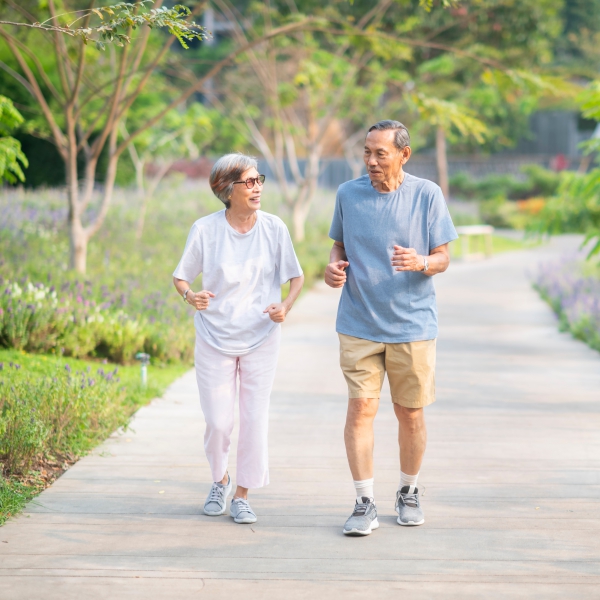Aging Strong: How to Preserve your Muscle Mass
“Aging Strong: How to Preserve your Muscle Mass”

Sarcopenia refers to the loss of muscle mass, strength, and bodily functions that is found in 1 in every 3 elderly people. The loss of muscle occurs more as a person ages, leading to deteriorating strength and mobility.
Although aging is the main cause of Sarcopenia, there are other factors at play. Factors like leading a sedentary lifestyle, hormonal changing, being diabetic, suffering from thyroid malfunctions, inflammation, as well as some medications can all worsen sarcopenia.
Sarcopenic elderly may experience lethargy and, in turn, are put off being physically active. This forces them into a cycle of further loss of muscle mass, which leads to higher risks of falling down, bone breakage, lower ability to carry out their daily tasks, and a functional decline that increases the risk of hospitalization and death.
To prevent Sarcopenia, elderly patients are recommended to stay active and maintain an appropriate diet. With continuously proper lifestyle, the elderly can also restore muscle mass.
Diet and exercise are vital for preserving muscle.
1. Regular exercise
Resistance and strengthening exercise are the best prevention against sarcopenia. Elderly patients are recommended to exercise all major muscle groups, including those in their legs, hips, chest, abdomen, arms, and shoulders. Joining a gym or purchasing equipment are not always necessary. Using one’s own body weight and equipment from household items, like a filled water bottle, is sufficient for a home exercise.
An elderly patient may start off with light weights over a brief session, and gradually increase the load along with the duration of their exercise. Once their muscle strength has increased, they should do 2-3 sets of strengthening exercise with 8-12 counts per set for each muscle group for the best outcome.
The United States’ Centers for Disease Control and Prevention (CDC) has recommended a 150-minute moderate level of aerobic-exercise per week for the elderly. For example, taking five 30-minute brisk walks per week. Or doing 75-minute intense aerobic-exercise per week, like running, swimming, and cycling. In combination, 2 days of strengthening exercise per week is also recommended; wall push-ups, quadriceps exercise, or any daily activities that involve muscle strengths, namely gardening, are good. Balance exercise, like Taichi, is also a great way to prevent falling down.
For example, taking five 30-minute brisk walks per week. Or doing 75-minute intense aerobic-exercise per week, like running, swimming, and cycling. In combination, 2 days of strengthening exercise per week is also recommended; wall push-ups, quadriceps exercise, or any daily activities that involve muscle strengths, namely gardening, are good. Balance exercise, like Taichi, is also a great way to prevent falling down.
Exercise is the key to strengthen overall body. In cases where elderly patients are unable to exercise, they can opt for doing more physical activities around the house, like gardening or cleaning. The most important thing is to try to stay active and be less sedentary. Research has confirmed that those who are physically active are able to retain their strength and fitness.
2. Maintain appropriate and proportional diet
Diet is also essential to retaining muscle mass. Elderly patients often find themselves with low appetite, gum and dental issues, or even become unable to fetch food for themselves. This may lead to less consumption of food, especially protein, which is crucial for muscle mass building. A study has confirmed that consuming a high-protein diet is beneficial for maintaining muscle mass. An elderly person without chronic renal disease is recommended 1-1.2 grams of protein intake per 1 kilogram of their body weight per day. For example, an elderly person weighing 50 kilograms is recommended to consume 50-60 grams of protein per day, especially those from easy-to-digest protein sources, like fish, tofu, cereal, milk, and legumes.
In addition to adequate daily protein intake, protein consumption should not pool into one particular meal in a day. According to a study conducted in 2009, an appropriate amount of protein per meal is no more than 30 grams in one meal. The study found that, when it comes to muscle building, there is no difference between consuming 30 grams of protein that provides 220 kilocalories per meal and consuming 90 grams of protein for 660 kilocalories per meal.
Branched Chain Amino acids (BCAA), like Leucine, Isoleucine, and Valine, along with Beta-Hydroxy-Beta-Methylbutyrate (ß-HMB), help strengthen muscles and aid its synthesis of protein. Elderly patients may choose supplements that contain these nutrients to enhance their regular meals.
Consume adequate amount of protein:
- The elderly need more protein to compensate for lower muscle mass, as well as other conditions they may be suffering.
- The elderly may struggle to consume food facing with conditions like anorexia of aging, chronic illness, or financial difficulties.
- It is recommended that the elderly consume 1-1.2 grams of protein per 1 kilogram of their body weight per day. The amount vary for each person, accordion to their weight.
Exercise:
- Doing regular exercise can help maintain muscle mass, strength, and their functions.
- Resistance and strengthening exercise is beneficial for muscle mass restoration in the elderly, and should be done together with an optimal protein intake.
‘Prevention is the key’
Prevention and delaying sarcopenia helps reduce the risk of health problems that may occur in the elderly. Muscle retention is comparable to a retirement fund investment. It is an investment whose return is yielded for the future, and both the elderly and their family should be more aware of the issue. Finding the proper diet and exercise necessary to care for the elderly and maintain their strength could be consulted by physicians and specialists on the subjects.
Article by BDMS Wellness Clinic Institute and Bangkok Association of Regenerative Health and The Study of Obesity (BARSO)
Reference:
- Deutz NE, Bauer JM, Barazzoni R, Biolo G, Boirie Y, Bosy-Westphal A, et al. Protein intake and exercise for optimal muscle function with aging: recommendations from the ESPEN Expert Group. Clinical nutrition. 2014;33(6):929-36.
- Meier NF, Lee DC. Physical activity and sarcopenia in older adults. Aging Clin Exp Res. 2020;32(9):1675-87.
- Symons, T.B.; Sheffield-Moore, M.; Wolfe, R.R.; Paddon-Jones, D. A moderate serving of high-quality protein maximally stimulates skeletal muscle protein synthesis in young and elderly subjects. J. Am. Diet. Assoc. 2009, 109, 1582–86.
- Centers for Disease Control and Prevention (2023) How much physical activity do older adults need?, Centers for Disease Control and Prevention. Available at: https://www.cdc.gov/physicalactivity/basics/older_adults/index.htm#:~:text=Adults% 20aged%2065%20 and%20older,of%20activities%20that%20strengthen%20muscles. (Accessed: 16 May 2024).




